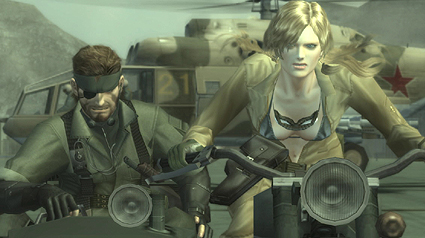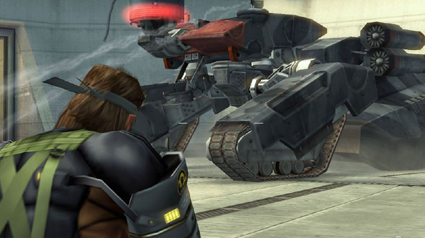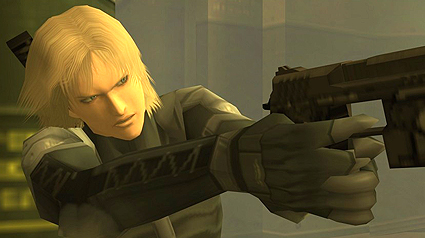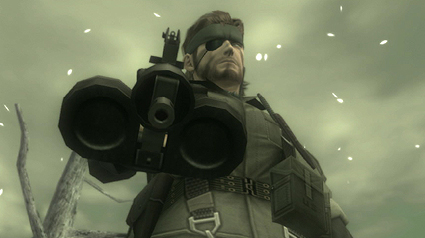Reviews
Metal Gear Solid: HD Collection
February 16, 2012, Author: Jesper Hauerslev
Hideo Kojima’s series of spy-games remain one of the most controversial game series’ in history, equally dividing the gaming masses into those that love the series for its unique quirkiness and those that despise it for the exact same reason.
The first game “snaked” its way onto the PlayStation in 1998 and since then, the series has successfully carved its very own niche in stealth-based gaming. Because of this, it’s remained unopposed thanks to its unique mix of stealth, gunplay and incredibly elaborate spy-plots exploring everything from loyalty and patriotism, to genetics and technology.
There is no denying that a Metal Gear Solid game is unlike anything you’ve ever played before and the Metal Gear Solid HD Collection brings three of the core entries together and presents them in glorious HD, for fans and newcomers to enjoy.
However, can it convert the non-believers while keeping true to the legacy that endeared the series to fans in the first place?
A snakes tale
The series may have officially launched in 1998 but was actually preceded nearly ten years earlier with Metal Gear and Metal Gear 2: Solid Snake, released in 1987 and 1990 respectively. These games introduced elite solider, Solid Snake, to the world and was one of the first games ever to employ a stealth-mechanic, which seemed to go against everything gaming was perceived to be at the time. Luckily, the stealthy approach to conflict struck a chord with fans who wanted more and got what they asked for when Metal Gear Solid was released on the PlayStation to rave reviews.
Part reboot and part sequel to the two original games, Metal Gear Solid unleashed Solid Snake on to the unsuspecting masses as he infiltrated yet another military base to destroy his mechanised nemesis, a walking tank codenamed Metal Gear, with the capability to launch nuclear warheads and start World War III. Metal Gear Solid was a visual feast that pushed the graphical capabilities of the PlayStation to its limits. The combination of stealth, a complicated and extravagant plot, outrageous characters and hardware-punishing visuals was later to become a staple in the series, with each new game pushing all the above further and further.
The inevitable sequel was released in 2001 in the form of Metal Gear Solid 2: Sons of Liberty, which marked the series first entrance on the PlayStation 2. Metal Gear Solid 3: Snake Eater followed in 2005 but was actually a prequel to the original from 1998. The series made the jump to PlayStation 3 in 2008 with a direct sequel to Sons of Liberty, in the form of Metal Gear Solid 4: Guns Of The Patriots.

Snake sure knows how to show a girl a good time.
Not to be outdone by its stronger and more successful cousin, the PSP got its own line of Metal Gear Solid-games as well when Metal Gear Solid: Portable Ops was released in 2006. Portable Ops followed on from the story in Snake Eater and got its own sequel in 2010 in Metal Gear Solid: Peace Walker.
The HD Collection bundles up three of these games: Metal Gear Solid 2, Metal Gear Solid 3 and Peace Walker, along with the two original Metal Gear-games as an added bonus. It brings them together in one collection, all remastered in sparkling, high-definition and presented in chronological order, kicking off with Snake Eater.
Snake Eater is set against the backdrop of the Cold War where Naked Snake, a young soldier working for a covert operations unit and father-to-be of Solid Snake, is about to embark on his first mission: rescuing a Soviet scientist from a secret weapons research facility deep in the Russian jungle.
The story of Naked Snake continues in Peace Walker which takes place in Costa Rica 10 years later, where Snake is busy building up his own army of mercenaries when he contacted by the Costa Rican government to repel an invading force.
Fast forward now to 2007, where Sons of Liberty opens with Solid Snake back as the leading man. This time, Snake’s mission is to sneak on to a giant tanker, which he suspects is actually carrying an advanced new version of Metal Gear. However, the tanker is suddenly attacked and sinks, taking both Metal Gear and Solid Snake with it. This paves the way for brand new protagonist Raiden. He is called into action when Big Shell, the giant marine decontamination facility constructed clean up the spillage from the sunken tanker, is suddenly attacked by terrorists. They are supposedly led by Solid Snake himself, and threaten to blow up Big Shell if their demands are not met.
To reveal more of the plots would be to spoil the enjoyment but suffice to say that every Metal Gear Solid-game follow more or less the same narrative formula. There is always an elaborate conspiracy at the heart of it all and things quickly go from bad to worse to downright bizarre so expect plenty of twists and turns along the way.
Slither and slide
While the series has grown in scale with each new release, every game has always stayed true to the core mechanic of using stealth rather than direct conflict. This in turn has been refined over the years with each new game giving Snake new moves, abilities and even gadgets to aid him in his quest. These range from the mundane, like aiming in first person, to game changers like blending in with the environment or building your own army and the HD Collection lets you witness this evolution first hand.
Snake Eater is good example of this. Up until its release, previous games in the series had all taken place in or around military bases or industrial complexes. Snake Eater, on the other hand, is set almost exclusively in thick jungle with very few walls and corners to hide behind but plenty of tall grass, hollow tree trunks and thick bush. The game lets you use this to your advantage by changing the patterns of Snake’s camouflage and face-paint to blend in with the environment.
The trick is to find the right camouflage-pattern for the right environment which is measured by your camouflage index. The higher the index, the more difficult you are to spot. This leads to some incredibly tense moments when patrolling guards are just inches away from your face as you lie prone in tall grass or pressed up against a tree in the hope that you camouflage-index is high enough for them not to notice you.
In true Bear Grylls-style, Snake can also hunt and eat the various wildlife in the jungle like snakes, toads, rats, fish and so on. Each posses unique abilities with some being able to restore energy and stamina while others are downright poisonous and bad for your health. The clever bit is that you don’t know whether your freshly caught snake or toad will heal you or hurt you until you’ve actually eaten it.
The innovation continued in Peace Walker, which is the game that has benefited the most from being included in the HD Collection as it now takes full advantage of having an extra stick on the joypad, making the controls much more fluid than on its previous incarnation for the PSP. Peace Walker also adds an important new gameplay-feature to the series in the form of recruitment, which ties in nicely with the game’s storyline. As he goes on missions, Snake can “recruit” new members to his private army by freeing POWs or by capturing enemy soldiers, who turn out to be surprisingly helpful once you get them back to your base.

Man versus machine.
Here, they can be put to work in the mess hall, sick bay, R&D department and so on or even sent on various side-missions. This in turn, gives your troops various morale boosts, lets you heal wounded soldiers and gives you access to new weapons and gadgets. These can be built using the points you earn on missions by performing various heroic acts like remaining undetected, favouring quiet takedowns instead of full on fist-fights, and so on. Peace Walker even comes with an online co-op mode, allowing you and your friends to work together to solve missions or engage in the game’s many boss-battles.
In comparison with the other games in the collection, Sons of Liberty is probably the one that has the least to offer in terms of gameplay innovation. Snake Eater has its camouflage-mechanic and Peace Walker has its recruitment and online co-op, where as Sons of Liberty has neither of the above. Not too surprisingly though, given the game was the first of the bunch to be released but it still makes it the odd one out. The omission of the original Metal Gear Solid from the HD Collection doesn’t do it any favours as its leaves massive gaps in the overall story that’s hard to miss.
This could have been forgiven somewhat if Metal Gear Solid had been your run-of-the-mill shooter, which it isn’t. Story, no matter how contrived, has always been a central pillar of any game in the series and without the original Metal Gear Solid to ease the transition, Sons of Liberty comes under immediate strain to prove its worth in a collection where it doesn’t really seem to belong.
Sons of Liberty also ditched fan-favourite Snake in favour of newcomer, Raiden, as its leading man, and even suggested that Snake had turned bad guy. This didn’t help when it was originally released and it remains the most controversial chapters in the saga, even after all these years. On its own terms, though, Sons of Liberty is still a very enjoyable game. It’s designed with the same quality and attention to detail as its forebears and does feature some iconic moments that are well worth the narrative confusion.
In some respects, it might actually have been better if Peace Walker had been left on the PSP instead. Don’t get me wrong. It’s great to have it in the collection and it benefits greatly from the transfer from small-screen handheld to proper console, but in the grand scheme of things, it feels more like filler then anything else. It does a disservice to newcomers, who will be lost once they start playing Sons of Liberty.

Raiden is well prepared if he runs into any angry fans.
The problem is that Peace Walker’s storyline, while important to the overall canon, is not essential in comparison with what happens in Metal Gear Solid. The gap makes the story in Sons of Liberty seem both incoherent and downright bewildering, because Metal Gear Solid introduces many of the central characters and important plot-points that Sons of Liberty is built on.
PlayStation-owners can rectify this somewhat, as the original Metal Gear Solid is available on PlayStation Network but it should really have been included as a downloadable part of the overall package to offer a much more complete experience.
Hardware punishment
Metal Gear Solid-games have always looked great. They have always pushed and punished the hardware to within an inch of its capabilities to squeeze out some truly spectacular visuals. They have always made the most of their pseudo-realistic setting to present both elaborate environments, outrageous characters and epic cut-scenes.
The move to HD-capable consoles like the Xbox 360 and PlayStation 3 has certainly not made them look any worse although they might not look as impressive as they did on release. For Peace Walker, the HD conversion is a rather bittersweet blessing as it looks quite blocky on a big screen. Still, Peace Walker is quite capable at holding its own and it’s a credit to the developers as to how much they managed to wring out of the PSP for it to still look this good on a HD console.
Hamming it up
Just as the visuals of a Metal Gear Solid game are always top-notch, so is the sound. From the music to the voice overs and sound-effects, everything oozes Hollywood-blockbuster.
This is in part attributed to long-serving Hollywood-composer Harry Gregson-Williams’ riveting scores but also to the cast who give it all they’ve got to bring the characters to life. Fronted by actor David Hayter’s trademark gruff voice as Snake, the cast ham it up wherever they can, which would have sounded awful in any other game but perfectly fits the dramatic grandeur that your average Metal Gear Solid-game demands.
Brothers in arms
Mutiplayer has never really been a central part of the Metal Gear Solid franchise, but that hasn’t stopped it from trying. Multiplayer was introduced in Metal Gear Solid 4 but greatly refined for Peace Walker, where the focus shifted from the standard deathmatch offerings in favour of co-op. The game still spots the usual deathmatch and team deatchmatch options, but the co-op remains the main attraction.
As previously mentioned, it allows you and a friend to team up when on missions or taking down bosses. Having a few friends by your side gives you a whole new range of options for eliminating enemies. You can work in tandem, with one of you distracting the guard while the other sneaks up from behind and so on. It’s a great feature and a great use of co-op that complements the game’s core mechanic rather then subtract from it.

"Do you feel lucky... punk?!"
A loveable rogue
Revered by some and despised by others, Hideo Kojima remains the lovable rogue of game design and his impact on gaming can’t be denied. You will either see him as a great visionary with a truly unique approach to games, who knows how to bend the medium to suit his will and how to tell stories and craft experiences unlike any other.
If not, you will see him as nothing more but a frustrated film maker with a poisonous disregard for the game medium. One who spends way too much time cooking up overly complicated plots, fashioning unbelievable characters and dishing out cut-scenes that go on for way too long.
No matter what you think of him, having three of his games together in one collection is a gaming treat unlike any other and an important collection for any gamer to own: There is no denying that each game in the HD Collection represents some of the best in gaming-history. The novelties and charms of each iteration are kept intact and there are plenty of memorable and classic moments in store.
However, the enjoyment of the overall story suffers because the original Metal Gear Solid is missing in action. Everything started with Solid Snake, but for such an iconic game-character, headlining an equally iconic franchise, he has surprisingly little game time in his own HD Collection. That is all left to his father, Naked Snake, and his “understudy”, Raiden.
Despite some shortcomings, it’s hard to find a better nostalgic trip for the experienced Metal Gear-vet or a better starting point for new players as long as they know what they are getting themselves in for. The Metal Gear Solid-series take place in a strange pseudo-realistic, alternate reality that is heavily inspired by real world events but still plays it fast and loose with history, fact and even common sense (there are no jungles in Russia for a start).
As a new player, you therefore have to be willing to suspend your disbelief to an extent that few other games require. The flipside of that is you are guaranteed a gaming tour-de-force unlike anything you have ever played or ever will play. Period.
That promise alone is well worth the price of admission for veterans and newcomers alike.
Platforms: PS3, Xbox 360 | Tagged Hideo Kojima, Metal Gear, Metal Gear Solid, Metal Gear Solid 3 Snake Eater, Metal Gear Solid: Peace Walker, Metal Gear Solid: Sons of Liberty, Naked Snake, Solid Snake



